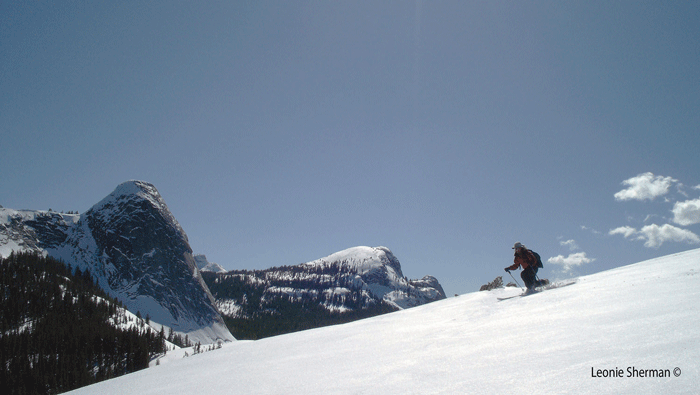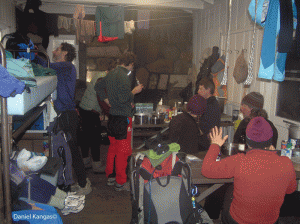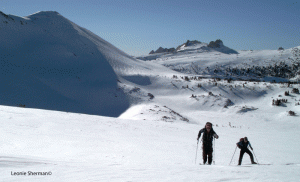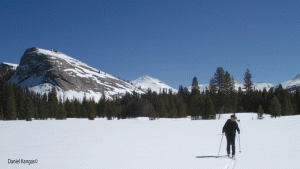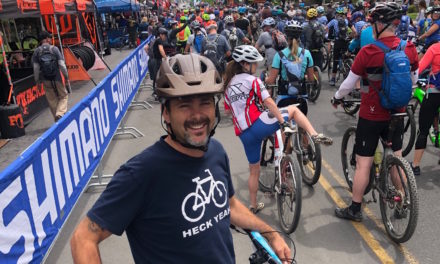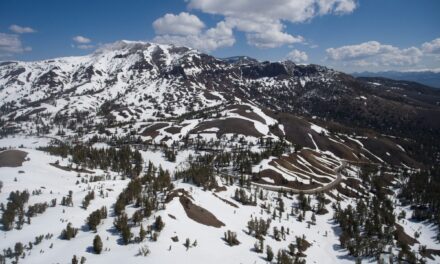- Death Valley’s Battle With Climate Extremes - 01/01/2024
- The Future of Homewood - 12/05/2023
- Kula Cloth - 10/18/2023
The Tuolumne Meadows Ski Hut provides warmth and companionship for Sierra pilgrims
By Leonie Sherman • Photos by Daniel Kangas
Modern skis have grown fat to accommodate a need for excitement and adrenaline in a fast paced, media driven world. But those long sleds we attach to our feet were first designed to facilitate travel in the mountains during long, snowy winters. A ski tour in Tuolumne Meadows allows you to connect with ancestors of yore by using skis for their original purpose. So, just for a while, forget shredding, carving, and turning and concentrate on the simplicity and improbable beauty of gliding over seven feet of crystallized water in its fluffiest form. Explore anywhere you please, because trails no longer matter. You’ll see Tuolumne as never before, in a way you’ll never forget.
I used to mourn the first flurries of the season. All that snow buried my favorite alpine wonderland, making granite crags and placid lakes inaccessible. Oh sure, I could join the crowds at Tahoe or Mammoth, but an expensive sport that relies on chairlifts for elevation gain somehow defies the very essence of what I love about mountains. So I sat and sulked and schemed about summer rambles and scrambles, until I heard rumors of a free ski hut in the high country of Yosemite National Park.
So my fifth day on skis found me just west of Lee Vining, contemplating the 16 miles and 2700 ft. of elevation gain between the Tuolumne Meadows Ski Hut and myself.
There’s no fee when you travel this section of Highway 120, AKA the Tioga Road, on skis. There are no lines of belching RVs. There’s no asphalt. There are only drifted over outbuildings, half-buried road signs and a whistling of wind through silence so profound your bones ache. On this normally crowded road, in deepest darkest winter, you can sink into stillness unlike any summer Sierra backcountry experience.
Eight miles from Tioga Pass, just beyond Lembert Dome and over the Tuolumne River, the National Park Service has transformed a stone hut into a haven for weary skiers. Ten bunks, an ample supply of wood and the prospect of good company beckon. The price of admission is your own exertion as you battle the brutal winds at Ellery corner and the time warp of a three mile long tree tunnel past Dana Meadows.
The significance of a warm free hut in wilderness is best grasped during a bitter 14-hour tent-bound night in single digit temperatures. After a day of carving big-grin turns on untracked snow, you can relax around a crackling woodstove swapping yarns with new friends, instead of shivering in your sleeping bag while melting snow to heat up noodles. The enormous bear cache allows those with foresight to put in a stash of food
and ski up the road with a light pack and visions of the fifth of whiskey deposited last October dancing in their heads.
The Tuolumne Meadows Ski Hut doesn’t just make the high country of Yosemite accessible in winter; it provides a safe and gentle introduction to snow camping. With the possibility of retreat to warmth and shelter, and resident rangers to facilitate a rescue, you can learn the skills necessary for more ambitious ski tours in years to come.
Don’t make the same mistake I did and trudge up Highway 120 on clunky resort telemark gear. Those fat smooth skis are perfect for shredding steep groomed slopes, but they feel like concrete ankle weights when you’re following the evenly graded surface of Highway 120. Plus, without scales, you’ll need to wear skins for the first eight miles—a major drag, literally.
Let’s call it what it is: cross-country skiing. Whether your eventual goal is a series of mellow tours in the meadows, or to rip turns on every north-facing slope in sight, you’re still skiing 16 miles on an evenly graded road to get to Tuolumne Meadows.
What you need is a versatile ski, light and thin enough to kick and glide, with ample side-cut for control on steep terrain and scales to eliminate the hassle of skins on gentle inclines. Serious ski geeks have a quiver of skis, but if you own a pair of Fischer Out of Bounds or Madshuss Epochs, you only need one. Two-buckle plastic boots or old school leather-touring boots will keep you blister free. This combo will take you anywhere you want to go and leave you smiling when you get there.
Skiing a road has some major advantages: you won’t get lost and the grade is mellow enough for beginners. Tioga Road skirts the edge of Lee Vining canyon and provides excellent views of high peaks, frozen waterfalls and frozen lakes. It presents only one major obstacle that must be managed carefully: the Blue Slide, and the gullies just beyond.
In summer, this area is a scar through a hillside in motion. It’s clearly a losing battle to keep this ribbon of asphalt free of constantly falling debris. Caltrans workers labor constantly to keep traffic flowing.
In winter, the entire section of road east of the Warren Fork is a death trap. If you don’t plan carefully, your last sight could be several tons of roaring snow, sweeping you a thousand feet to the bottom of the canyon. Also, the Sierra freeze-thaw cycle can coat the road in bulletproof ice that creates a luge chute to the canyon floor. A lost ski edge at the wrong time could have serious consequences.
The safest way to navigate this hazard is with careful timing. Don’t even think about venturing up the Tioga Road until a minimum of 48 hours after a big storm. Consider the Warren Fork a safe point; leave early in the morning and race for it, passing the major avalanche danger when everything is still frozen hard. Don’t waste time after you leave the car; consider the first few miles of your journey a cardio challenge and go for it.
Once you reach the Warren Fork you can relax and take your time cruising the remaining miles. Since the hut is first come/first served, there is no guarantee of an available bunk and you must carry a tent anyway; consider spending a night en route. From the pass there is no need to follow the road, so a ramble through upper and lower Dana Meadows is highly recommended. Keep in mind that you will not be sliding down from the pass to the meadows. The incline is so gradual that you will need to kick and glide downhill, but the upside is that the cruise back up will be a cakewalk.
Expect to share the hut with other people. I’ve met some of my favorite backcountry companions there. Try to see other users as a fun and interesting part of your experience, not as intrusions. Practice hut etiquette by keeping your stuff consolidated, managing noise levels and sharing common duties like keeping the stove lit and a supply of melted snow available in one of the large pots provided.
Be prepared to pitch your tent if the hut is full. The flats by Parson’s Lodge get early morning sun, as does the parking lot in front of Lembert Dome. Feel free to respectfully crowd into the hut for meals and socializing, but keep your impact minimal, and be sensitive to other hut users who got there first.
When you have exhausted your food supplies, or work demands you depart, you will leave with a sense of accomplishment and deep reverence, as well as gratitude to the park for keeping this humble hut open to the public. Don’t hesitate to write them a letter expressing your appreciation and hope that this place will remain open to delight visitors for years to come.
———————————————————————————————————————————————————————————————-
Day Trips from the Tuolumne Ski Hut
Welcome to Tuolumne Meadows in the winter months! The ski hut is a perfect basecamp for a variety of adventures to accomodate every skill level and desire, from mild to extreme.
The bunny slopes are at the far end of the meadow, on Pothole Dome. This is a fantastic gentle slope where beginners can practice turns within sight of safety. A day of running laps on this dome will give you the confidence to tackle more serious objectives. The mild incline behind Parson’s Lodge is a great place to perfect your wedge, AKA your snowplow technique.
Telemark Dome is the place to advance your skills. To get there, ski across the Meadows until you find the trail towards Glen Aulin. Follow the trail a few miles until you see the open slopes of the dome running down to the Tuolumne River. This makes a great day trip and is suitable for a variety of skill levels, since you can ski however high up the dome you want.
My favorite challenge is Unicorn Saddle. This is the obvious dip between Unicorn Peak and the oddly named lump informally called Altuski, just to the south. Follow the road past a creek crossing, and then head into the forest towards Elizabeth Lake and start climbing. The expansive views from the saddle, north to Conness and west down the precipitous drop
into Budd Creek are worth the climb in themselves, but the descent is still ahead of you. The slope is about 40 degrees, but the surface is often wind-boarded, providing an exciting test of your skills.
On the other hand, maybe you dusted off an old pair of skinny sticks and came only to immerse yourself in the splendor of Tuolumne Meadows National Park, the largest alpine meadow in the Sierra returned to a motor-free state. There are many days of Nordic touring to be enjoyed by the quiet-loving visitor.
A gentle cruise around the meadows will soothe muscles exhausted by the 16-mile approach. A tour out towards Tenaya Lake will reward you with a new perspective on familiar summer haunts. Why not spend a night at Olmstead Point? You can laugh at the desolation of this normally crowded parking lot, now visited only by determined Marmots and yourself.
Whether you came to shred the steeps or just soak up the magic, Tuolumne Meadows in winter has something for everyone.

